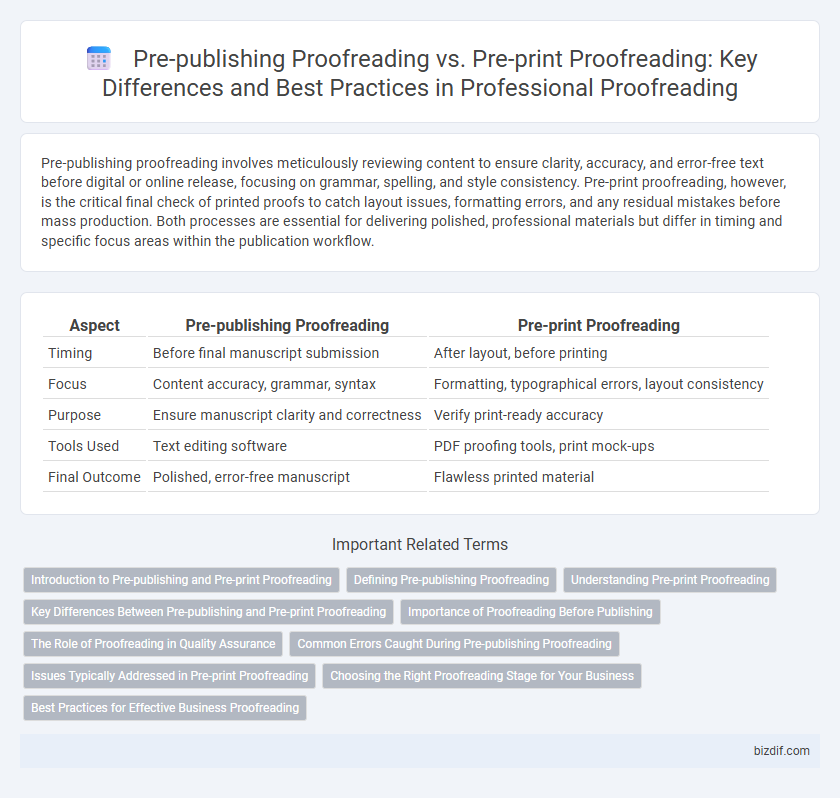Pre-publishing proofreading involves meticulously reviewing content to ensure clarity, accuracy, and error-free text before digital or online release, focusing on grammar, spelling, and style consistency. Pre-print proofreading, however, is the critical final check of printed proofs to catch layout issues, formatting errors, and any residual mistakes before mass production. Both processes are essential for delivering polished, professional materials but differ in timing and specific focus areas within the publication workflow.
Table of Comparison
| Aspect | Pre-publishing Proofreading | Pre-print Proofreading |
|---|---|---|
| Timing | Before final manuscript submission | After layout, before printing |
| Focus | Content accuracy, grammar, syntax | Formatting, typographical errors, layout consistency |
| Purpose | Ensure manuscript clarity and correctness | Verify print-ready accuracy |
| Tools Used | Text editing software | PDF proofing tools, print mock-ups |
| Final Outcome | Polished, error-free manuscript | Flawless printed material |
Introduction to Pre-publishing and Pre-print Proofreading
Pre-publishing proofreading ensures the manuscript is polished for content accuracy, grammar, and style before final production stages, addressing errors early to enhance overall quality. Pre-print proofreading, conducted just before the printing process, focuses on detecting any remaining typographical, layout, or formatting issues to prevent costly printing errors. Both stages are crucial for a professional, error-free publication, with pre-publishing emphasizing comprehensive text review and pre-print targeting visual and technical accuracy.
Defining Pre-publishing Proofreading
Pre-publishing proofreading involves meticulously reviewing a manuscript before it proceeds to final formatting and layout stages to ensure grammatical accuracy, consistency, and clarity. This process emphasizes catching errors early, including typographical mistakes, punctuation issues, and syntactical flaws, to prevent costly revisions during later production phases. Pre-publishing proofreading serves as a critical quality control step, enhancing the overall readability and professionalism of the content before it moves to pre-print proofreading.
Understanding Pre-print Proofreading
Pre-print proofreading is a critical final review stage ensuring all content is error-free, formatted correctly, and consistent before mass printing. Unlike pre-publishing proofreading, which may occur earlier in the editorial process, pre-print proofreading focuses on verifying page layouts, fonts, and graphic placements to prevent costly printing errors. This phase helps maintain publication quality and safeguards the author's professional reputation by catching last-minute mistakes.
Key Differences Between Pre-publishing and Pre-print Proofreading
Pre-publishing proofreading primarily focuses on correcting content, grammar, and syntax errors to ensure the manuscript's overall clarity and coherence before final formatting. Pre-print proofreading, however, emphasizes checking layout, design, and typographical details on the formatted pages to detect issues that might affect print quality. The key difference lies in pre-publishing proofreading addressing the textual accuracy, while pre-print proofreading ensures the visual and mechanical precision of the final printed material.
Importance of Proofreading Before Publishing
Pre-publishing proofreading ensures content accuracy, consistency, and error-free text, preventing costly mistakes before market release. Pre-print proofreading focuses on detecting and correcting errors in the final print layout, safeguarding print quality and brand reputation. Comprehensive proofreading before publishing enhances reader trust, reduces legal risks, and maximizes the overall impact of the published material.
The Role of Proofreading in Quality Assurance
Pre-publishing proofreading ensures manuscript accuracy by correcting grammatical errors and inconsistencies before final layout, enhancing the overall readability and professionalism of the text. Pre-print proofreading focuses on detecting layout issues, typographical mistakes, and color mismatches in the formatted document, preventing costly errors during printing. Both stages are crucial in quality assurance, guaranteeing that the final publication meets industry standards and reader expectations.
Common Errors Caught During Pre-publishing Proofreading
Pre-publishing proofreading commonly catches errors such as inconsistent spelling, grammatical mistakes, and formatting issues that can undermine the clarity and professionalism of the manuscript. This stage also identifies plot inconsistencies and character name errors that disrupt narrative flow, which pre-print proofreading may not address. Detecting these issues early ensures that the final printed version maintains high quality and reader engagement.
Issues Typically Addressed in Pre-print Proofreading
Pre-print proofreading primarily targets formatting inconsistencies, design layout errors, and final typographical mistakes that could affect the physical appearance of the publication. This stage also emphasizes checking color accuracy, image resolution, and bleed settings to ensure fidelity in print production. Addressing these issues minimizes costly reprints and guarantees a polished final product for market release.
Choosing the Right Proofreading Stage for Your Business
Pre-publishing proofreading ensures all textual elements are polished before layout design, catching errors in grammar, spelling, and syntax that could affect readability and professionalism. Pre-print proofreading occurs after formatting, focusing on visual consistency, font accuracy, and layout issues to prevent costly printing mistakes. Selecting the right proofreading stage depends on the project's complexity, budget, and desired quality, optimizing the final product's impact and cost-efficiency.
Best Practices for Effective Business Proofreading
Pre-publishing proofreading focuses on reviewing content for grammar, spelling, and coherence before final layout design, ensuring the text is accurate and clear for readers. Pre-print proofreading involves a detailed check of the formatted pages, highlighting layout issues, font inconsistencies, and potential printing errors to avoid costly mistakes during production. Implementing systematic checklists and using professional proofreading tools enhances accuracy and consistency in both stages, promoting a polished and professional business publication.
Pre-publishing Proofreading vs Pre-print Proofreading Infographic

 bizdif.com
bizdif.com